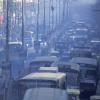
India's road transport transition requires energy efficiency and cleaner energy sources to combat emissions growth and air pollution.
India's road transport sector plays a crucial role in the country's clean energy transition, but it also poses significant environmental challenges, with rising CO2 emissions and air pollution. Currently, road transport contributes 12 percent of India's energy-related CO2 emissions and is a major contributor to urban air pollution. Without ambitious policies, energy use and CO2 emissions from road transport could double by 2050 due to the increasing demand for private mobility and goods transport. However, implementing ambitious policies and measures could lead to a 30 percent reduction in energy demand and 60 percent reduction in CO2 emissions by 2050, aligning with the country's goal of reaching net zero carbon emissions by 2070.
A new report “Transitioning India’s Road Transport Sector: Realising climate and air quality benefits” by the International Energy Agency (IEA) and NITI Aayog (a premier policy Think Tank of the Government of India) highlights that current policies may not be sufficient to address this emissions growth. The report suggests policy options to expedite the transition to sustainable road transport, emphasizing energy efficiency improvements and adopting cleaner energy sources. Using IIASA’s GAINS model the report highlights that rapid decarbonization efforts can effectively address India's air pollution challenge.
The report emphasizes the considerable co-benefits of improving air quality through reducing transport-related emissions in India. Air pollution is a major environmental concern in the country, with a large share of emissions affecting urban areas and people directly. Road transport contributes significantly to urban air pollution, accounting for 20-30 percent of it. “Measures such as implementing Bharat Stage (BS) emission standards and transitioning to vehicle electrification have positive impacts on air quality and public health, leading to a projected 15-20 percent reduction in NOx emissions by 2030” says IIASA researcher Pallav Purohit.
The vehicle scrappage policy of 2021 also shows potential in reducing air pollution by replacing older vehicles with newer, BS-VI compliant trucks, avoiding significant amount of NOx and PM2.5 emissions. Establishing more testing centers and linking incentives to finance access can enhance the policy's effectiveness. Implementing low-emission zones and reducing circulation of polluting vehicles in densely populated areas can further curb air pollution.
To promote the adoption of electric vehicles (EVs) in India's road transport sector, policymakers must continue demand incentives and maintain favorable taxation for EVs. “Measures such as establishing low-emission zones, imposing stringent fuel economy standards or zero-emission vehicle (ZEV) requirements can further accelerate the adoption of EVs” says Purohit.
News

20 December 2024
Increase in electric vehicles could create unwanted pollution hotspots

05 November 2024
How ecosystem restoration benefits national policies

12 August 2024

